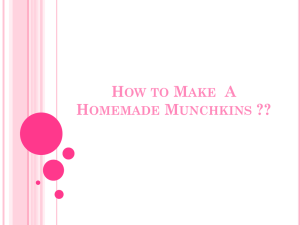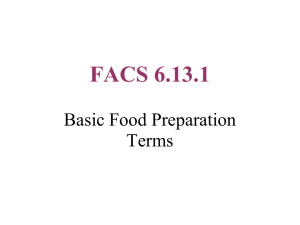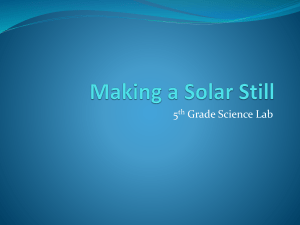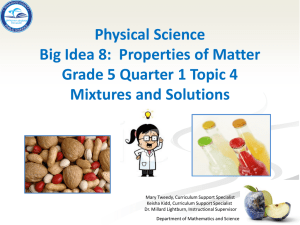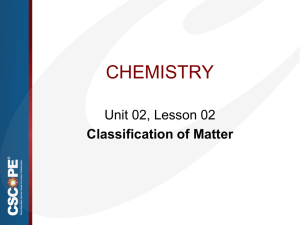PhysicalBootCamp_5.5C
advertisement
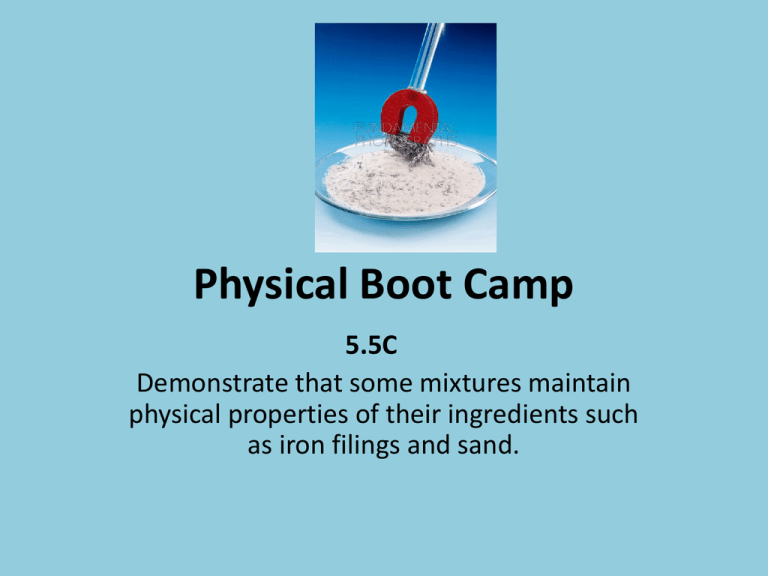
Physical Boot Camp 5.5C Demonstrate that some mixtures maintain physical properties of their ingredients such as iron filings and sand. STAAR 2013 #21; RC1; Supporting 1. A mixture of beads was placed in a container, as shown below. The beads are of various sizes and each one is made of plastic, glass, or steel. The mixture would be easily to separate because all the beads— A. are less dense than water B. are solids C. have the same mass D. are attracted to a magnet STAAR 2013 #21; RC1; Supporting 1. A mixture of beads was placed in a container, as shown below. The beads are of various sizes and each one is made of plastic, glass, or steel. The mixture would be easily to separate because all the beads— A. are less dense than water B. are solids C. have the same mass D. are attracted to a magnet TAKS Study Guide, #21 2. A student stirs together a mixture of hot water and small amounts of salt, sand, and sugar. The student then pours the mixture through a paper towel. Which substance or substances will collect on the paper towel? A B C D Only the sugar Only the sand Both the salt and the sugar Both the salt and the sand TAKS Study Guide, #21 2. A student stirs together a mixture of hot water and small amounts of salt, sand, and sugar. The student then pours the mixture through a paper towel. Which substance or substances will collect on the paper towel? A B C D Only the sugar Only the sand Both the salt and the sugar Both the salt and the sand 3. 3. 2004—#22 (78%) 4. Carbon powder and iron filings are both black powders. When mixed together, they look like one black powder. Which of these would be best to use to separate the iron filings from the carbon powder? F G H J A magnifying glass Heat A magnet Water 2004—#22 (78%) 4. Carbon powder and iron filings are both black powders. When mixed together, they look like one black powder. Which of these would be best to use to separate the iron filings from the carbon powder? F G H J A magnifying glass Heat A magnet Water 2006—#7 (89%) 5. A company collects cans for recycling. Some cans are made of aluminum, and some are made of iron. Which of the following is the best way to separate the two types of cans? A B C D Heat the iron cans until they melt Use scissors to cut the cans Use a magnet to pick up the iron cans Float the cans in water 2006—#7 (89%) 5. A company collects cans for recycling. Some cans are made of aluminum, and some are made of iron. Which of the following is the best way to separate the two types of cans? A B C D Heat the iron cans until they melt Use scissors to cut the cans Use a magnet to pick up the iron cans Float the cans in water 2008—#3 6. A student mixes three spoonfuls of sand with one cup of war water in an open container. The student puts the container of sand and water near a window for four days. How many spoonfuls of sand will be in the container when all of the water has evaporated? A B C D 1 2 3 4 2008—#3 6. A student mixes three spoonfuls of sand with one cup of war water in an open container. The student puts the container of sand and water near a window for four days. How many spoonfuls of sand will be in the container when all of the water has evaporated? A B C D 1 2 3 4 2009—#38 (94%) 7. Which of these mixtures would be easiest to separate? F G H J Fruit salad Powdered lemonade Hot chocolate Instant pudding 2009—#38 (94%) 7. Which of these mixtures would be easiest to separate? F G H J Fruit salad Powdered lemonade Hot chocolate Instant pudding 2011—STAAR™ Released Test Questions, #3 8. A small bowl contains a mixture of toothpicks and glass marbles. The easiest way to separate the mixture without touching it would be to— F G H J add glue to the mixture place a magnet in the bowl pour the mixture into a paper cone add water to the bowl 2011—STAAR™ Released Test Questions, #3 8. A small bowl contains a mixture of toothpicks and glass marbles. The easiest way to separate the mixture without touching it would be to— F G H J add glue to the mixture place a magnet in the bowl pour the mixture into a paper cone add water to the bowl 9. Which of these mixtures can be separated by using a magnet? A B C D A mixture of sand and sugar A mixture of sand and iron pieces A compound of hydrogen and oxygen A compound of sugar and water 9. Which of these mixtures can be separated by using a magnet? A B C D A mixture of sand and sugar A mixture of sand and iron pieces A compound of hydrogen and oxygen A compound of sugar and water 10. Some students made trail mix by putting peanuts, chocolate chips, and raisins in a bowl. Why did the trail mix taste both sweet and salty? A The peanuts and the raisins were both crunchy and soft. B The peanuts stayed salty while the raisins and chocolate chips stayed sweet. C The peanuts remained sweet while the raisins stayed crunchy. D The chocolate chips, and the raisins were very salty. 10. Some students made trail mix by putting peanuts, chocolate chips, and raisins in a bowl. Why did the trail mix taste both sweet and salty? A The peanuts and the raisins were both crunchy and soft. B The peanuts stayed salty while the raisins and chocolate chips stayed sweet. C The peanuts remained sweet while the raisins stayed crunchy. D The chocolate chips, and the raisins were very salty. 11. A fifth grade student added some salt, sugar, sand, and rocks to a jar of water and then shook it up to mix everything together. Which substances kept their own physical properties when mixed with the water? A B C D Sand and sugar Rocks and salt Sugar and salt Sand and rocks 11. A fifth grade student added some salt, sugar, sand, and rocks to a jar of water and then shook it up to mix everything together. Which substances kept their own physical properties when mixed with the water? A B C D Sand and sugar Rocks and salt Sugar and salt Sand and rocks 12. 12. 13. What physical property of milk remains the same when it is mixed with chocolate syrup? A B C D Color Taste State Aroma 13. What physical property of milk remains the same when it is mixed with chocolate syrup? A B C D Color Taste State (still a liquid) Aroma 14. Which of the following solutions is composed completely of gases? A B C D Milk Sprite® Air Salad 14. Which of the following solutions is composed completely of gases? A B C D Milk Sprite® Air Salad 15. The ingredients or parts in a mixture— A B C D join together to form new matter can never be separated can be physically separated become chemically joined 15. The ingredients or parts in a mixture— A B C D join together to form new matter can never be separated can be physically separated become chemically joined 16. You are given a beaker containing a mixture of salt and water. How could you separate this mixture? A Let the salt settle out of the water and pour off the pure water. B Evaporate the water and collect the salt left behind. C Put the mixture under a microscope to separate the salt and water. D Use an electromagnet to separate the salt from the water. 16. You are given a beaker containing a mixture of salt and water. How could you separate this mixture? A Let the salt settle out of the water and pour off the pure water. B Evaporate the water and collect the salt left behind. C Put the mixture under a microscope to separate the salt and water. D Use an electromagnet to separate the salt from the water. 17. 17. 18. Which physical property of salt does not change when it is mixed with water? A B C D Texture Size Taste Shape 18. Which physical property of salt does not change when it is mixed with water? A B C D Texture Size Taste Shape 19. How could you separate a mixture of sand and iron filings most easily? A Stir the mixture into a glass of water and let the water evaporate. B Place the mixture in a glass beaker and heat it for 20 minutes. C Place the mixture on a piece of paper and move a magnet through it. D Use a pair of pointed tweezers to pick out all of the iron filings. 19. How could you separate a mixture of sand and iron filings most easily? A Stir the mixture into a glass of water and let the water evaporate. B Place the mixture in a glass beaker and heat it for 20 minutes. C Place the mixture on a piece of paper and move a magnet through it. D Use a pair of pointed tweezers to pick out all of the iron filings. 20. 20. 21. In the mixtures below, all of the ingredients keep their same physical properties when mixed EXCEPT— A B C D a tossed salad gravel and sand dried cereal and milk spaghetti and meatballs 21. In the mixtures below, all of the ingredients keep their same physical properties when mixed EXCEPT— A B C D a tossed salad gravel and sand dried cereal and milk spaghetti and meatballs 22. Salt water is a mixture where the particles of salt dissolve in and spread evenly throughout the water. How could salt be separated from the water? A Boil the mixture until the water evaporates. B Freeze the mixture until the salt sinks to the bottom. C Pour the mixture through several layers of coffee filters. D Run a magnet through the mixture to remove the salt particles. 22. Salt water is a mixture where the particles of salt dissolve in and spread evenly throughout the water. How could salt be separated from the water? A Boil the mixture until the water evaporates. B Freeze the mixture until the salt sinks to the bottom. C Pour the mixture through several layers of coffee filters. D Run a magnet through the mixture to remove the salt particles. 23. In a container, a mixture of water and salt is stirred so that the salt dissolves completely. Sand is added to this solution and allowed to settle to the bottom of the container. If the container is placed on a heat source and the liquid evaporates completely, what will be left in the container? A B C D Nothing will remain in the container. Only salt will remain in the container. Only sand will remain in the container. Salt and sand will both remain in the container. 23. In a container, a mixture of water and salt is stirred so that the salt dissolves completely. Sand is added to this solution and allowed to settle to the bottom of the container. If the container is placed on a heat source and the liquid evaporates completely, what will be left in the container? A B C D Nothing will remain in the container. Only salt will remain in the container. Only sand will remain in the container. Salt and sand will both remain in the container. 24. 24. 25. A student has a mixture of soil and water in a jar. Which of the following tools would best help the student separate the soil from the water? A B C D A filter A measuring cup A triple beam balance A hand lens 25. A student has a mixture of soil and water in a jar. Which of the following tools would best help the student separate the soil from the water? A B C D A filter A measuring cup A triple beam balance A hand lens 26. A student has been given samples of five different substances: salt, sugar, gravel, wood chips, and iron filings. Which two substances, if mixed together in a glass of water, will the student be unable to separate easily from each other once the water has been evaporated? A B C D Salt and sugar Sugar and gravel Gravel and iron filings Iron filings and wood chips 26. A student has been given samples of five different substances: salt, sugar, gravel, wood chips, and iron filings. Which two substances, if mixed together in a glass of water, will the student be unable to separate easily from each other once the water has been evaporated? A B C D Salt and sugar Sugar and gravel Gravel and iron filings Iron filings and wood chips 27. Steel cans are separated from aluminum cans in a recycling center. Which of the following is the BEST way the recycling center can separate the steel cans from the aluminum cans? A B C D Sort the cans by size Put the cans in water Cool the cans to a low temperature Put the cans under an electromagnet 27. Steel cans are separated from aluminum cans in a recycling center. Which of the following is the BEST way the recycling center can separate the steel cans from the aluminum cans? A B C D Sort the cans by size Put the cans in water Cool the cans to a low temperature Put the cans under an electromagnet 28. 28. 29. Which of these is a mixture? A B C D Salt Water Lemonade Sugar 29. Which of these is a mixture? A B C D Salt Water Lemonade Sugar 30. A student put some salt, sugar, and rocks in a cup of warm water and then shook the cup. If the mixture in the cup was poured through a filter, what would remain on the filter? A B C D The sugar The sugar and the salt The water The rocks and some water 30. A student put some salt, sugar, and rocks in a cup of warm water and then shook the cup. If the mixture in the cup was poured through a filter, what would remain on the filter? A B C D The sugar The sugar and the salt The water The rocks and some water 31. Which physical property could be used to separate some corks from some rocks? A B C D The corks float in water. The corks are magnetic. The corks dissolve in water. The rocks dissolve in water. 31. Which physical property could be used to separate some corks from some rocks? A B C D The corks float in water. The corks are magnetic. The corks dissolve in water. The rocks dissolve in water. 32. Which of the following is an example of a mixture? A B C D Water Sugar Salad Salt 32. Which of the following is an example of a mixture? A B C D Water Sugar Salad Salt 33. Which of the following mixtures cannot be separated easily by hand? A B C D Screws and nails Apples and oranges Nickels and dimes Salt and pepper 33. Which of the following mixtures cannot be separated easily by hand? A B C D Screws and nails Apples and oranges Nickels and dimes Salt and pepper 34. A mixture of pebbles and paper clips can be easily separated. Which physical property of the ingredients makes it easy to separate the mixture? A B C D Magnetism Color The ability to dissolve The ability to float 34. A mixture of pebbles and paper clips can be easily separated. Which physical property of the ingredients makes it easy to separate the mixture? A B C D Magnetism Color The ability to dissolve The ability to float 35. All of the following are physical properties of matter EXCEPT— A B C D magnetism its location in the room ability to conduct electricity ability to insulate heat 35. All of the following are physical properties of matter EXCEPT— A B C D magnetism its location in the room ability to conduct electricity ability to insulate heat 36. A student wants to separate a mixture of wood chips and marbles. If he puts the mixture in a bucket of water, what physical property will cause the mixture to separate? A B C D Color Density Conductivity Mass 36. A student wants to separate a mixture of wood chips and marbles. If he puts the mixture in a bucket of water, what physical property will cause the mixture to separate? A B C D Color Density Conductivity Mass M.S. ?’s 37. Which substances, when mixed together, maintain their original physical properties? A B C D gravel, sugar, water wood chips, water, sand sand, sugar, water water, pepper, sugar 37. Which substances, when mixed together, maintain their original physical properties? A B C D gravel, sugar, water wood chips, water, sand sand, sugar, water water, pepper, sugar 38. A student was preparing an investigation on mixtures using water, sand, and gravel. While stirring the mixture into the container of water, the sand and water mixture accidentally splashed into the student’s eyes. What safety precaution should the student have followed? A wash hands before investigating B wait for the other students before starting the investigation C wear safety goggles D use a spoon to stir the mixture 38. A student was preparing an investigation on mixtures using water, sand, and gravel. While stirring the mixture into the container of water, the sand and water mixture accidentally splashed into the student’s eyes. What safety precaution should the student have followed? A wash hands before investigating B wait for the other students before starting the investigation C wear safety goggles D use a spoon to stir the mixture 39. A student stirred a mixture of sand, iron filings, and a water and observed that eventually the sand and iron fillings sank to the bottom of the container. How can the student separate the mixture? A Slowly pour the mixture in another container, making sure the sand does not flow out with the water. Pick the iron up with tweezers. B Pour the mixture into a pot and heat one minute. Spoon the sand from the water. Use a magnet to pull out the iron. C Pour the mixture through a coffee filter, leaving only the sand and iron in the filter. Separate the sand and iron with a magnet. D Use a spoon and scoop out as much sand as possible. Drag a magnet through the water to remove the iron. 39. A student stirred a mixture of sand, iron filings, and a water and observed that eventually the sand and iron fillings sank to the bottom of the container. How can the student separate the mixture? A Slowly pour the mixture in another container, making sure the sand does not flow out with the water. Pick the iron up with tweezers. B Pour the mixture into a pot and heat one minute. Spoon the sand from the water. Use a magnet to pull out the iron. C Pour the mixture through a coffee filter, leaving only the sand and iron in the filter. Separate the sand and iron with a magnet. D Use a spoon and scoop out as much sand as possible. Drag a magnet through the water to remove the iron. 40. A student made a garden salad by stirring lettuce, tomatoes, carrots, and croutons together in a bowl. Why is the garden salad a mixture? A The student cut the vegetables into equally sized pieces. B The vegetables are combined but maintain their physical properties. C The croutons cannot be taken out of the salad. D The salad grew from a garden. 40. A student made a garden salad by stirring lettuce, tomatoes, carrots, and croutons together in a bowl. Why is the garden salad a mixture? A The student cut the vegetables into equally sized pieces. B The vegetables are combined but maintain their physical properties. C The croutons cannot be taken out of the salad. D The salad grew from a garden. 41. All of the following are examples of containers filled with mixtures EXCEPT— A B C D a jar filled with trail mix a glass filled with water a bowl of cereal with milk a cup of fruit salad 41. All of the following are examples of containers filled with mixtures EXCEPT— A B C D a jar filled with trail mix a glass filled with water a bowl of cereal with milk a cup of fruit salad 42. A mixture of iron fillings and chalk dust is placed on a plate. Which of the following could be done to gather the iron fillings? A B C D Pour the mixture into a funnel. Put the mixture in a pot on the stove. Run a magnet over the mixture. Filter the mixture through a strainer. 42. A mixture of iron fillings and chalk dust is placed on a plate. Which of the following could be done to gather the iron fillings? A B C D Pour the mixture into a funnel. Put the mixture in a pot on the stove. Run a magnet over the mixture. Filter the mixture through a strainer. 43. A packet of trail mix has raisins, nuts, granola, and cranberries. Which statement correctly describes the trail mix? A The trail mix is a mixture because it contains an equal number of nuts and raisins. B The trail mix is a mixture because the ingredient dissolve in water. C The trail mix is a mixture because the ingredients cannot be separated. D The trail mix is a mixture because the ingredients can be separated easily. 43. A packet of trail mix has raisins, nuts, granola, and cranberries. Which statement correctly describes the trail mix? A The trail mix is a mixture because it contains an equal number of nuts and raisins. B The trail mix is a mixture because the ingredient dissolve in water. C The trail mix is a mixture because the ingredients cannot be separated. D The trail mix is a mixture because the ingredients can be separated easily. 44. A cup of orange juice with pulp is poured into a glass. Which of these procedures could be done to separate the juice from the pulp? A Pour the juice through a coffee filter. B Heat the juice in a pot until boiling. C Pour the juice into another cup. D Allow the mixture to settle, leaving the pulp at the bottom of the glass. 44. A cup of orange juice with pulp is poured into a glass. Which of these procedures could be done to separate the juice from the pulp? A Pour the juice through a coffee filter. B Heat the juice in a pot until boiling. C Pour the juice into another cup. D Allow the mixture to settle, leaving the pulp at the bottom of the glass. 45. Which of the following mixtures can be separated using a magnet? A B C D sand and salt sand and iron fillings sugar and water saltwater 45. Which of the following mixtures can be separated using a magnet? A B C D sand and salt sand and iron fillings sugar and water saltwater 46. All of these can be separated easily EXCEPT— A B C D nuts, bolts, and screws powdered drink mix, sugar, and water sand and water iron fillings and sand 46. All of these can be separated easily EXCEPT— A B C D nuts, bolts, and screws powdered drink mix, sugar, and water sand and water iron fillings and sand 47. Which mixture can be separated using a filter? A B C D sand and iron fillings saltwater sand and water chocolate milk 47. Which mixture can be separated using a filter? A B C D sand and iron fillings saltwater sand and water chocolate milk 48. Which tools are best for separating a mixture of sand, iron fillings, and water? A B C D hot plate and filter tweezers and filter filter and magnet magnet and hot plate 48. Which tools are best for separating a mixture of sand, iron fillings, and water? A B C D hot plate and filter tweezers and filter filter and magnet magnet and hot plate 49. A new student has joined the science class. The student was not present when the class investigated mixtures and solutions. All the following would be good ways for the class to help the student learn about mixtures and solutions EXCEPT— A develop a model representing mixtures and solutions B take the student to the library and research mixtures and solutions C draw an illustration of mixtures and solutions D give the student a dictionary 49. A new student has joined the science class. The student was not present when the class investigated mixtures and solutions. All the following would be good ways for the class to help the student learn about mixtures and solutions EXCEPT— A develop a model representing mixtures and solutions B take the student to the library and research mixtures and solutions C draw an illustration of mixtures and solutions D give the student a dictionary 50. When separating saltwater using a hot plate, what precaution should students use? A Unplug the hot plate if water splashes on the cord. B Follow the teacher’s instruction and put on safety goggles. C Leave the hot plate plugged in after the investigation is complete. D Follow the teacher’s instructions and record results in a science notebook. 50. When separating saltwater using a hot plate, what precaution should students use? A Unplug the hot plate if water splashes on the cord. B Follow the teacher’s instruction and put on safety goggles. C Leave the hot plate plugged in after the investigation is complete. D Follow the teacher’s instructions and record results in a science notebook. 51. Following an experiment testing mixtures, which would be the best conclusion about simple mixtures? A After mixing, ingredients in a simple mixture develop new properties. B Stirring a simple mixture changes the properties of its ingredients. C A simple mixture can be easily separated. D A simple mixture dissolves in water. 51. Following an experiment testing mixtures, which would be the best conclusion about simple mixtures? A After mixing, ingredients in a simple mixture develop new properties. B Stirring a simple mixture changes the properties of its ingredients. C A simple mixture can be easily separated. D A simple mixture dissolves in water. 52. Students are investigation a mixture of oil and water. They notice when the mixture is stirred vigorously it appears to mix evenly, but after letting the mixture rest, the oil floats on top of the water. The students are making— A B C D an inference a conclusion an observation a prediction 52. Students are investigation a mixture of oil and water. They notice when the mixture is stirred vigorously it appears to mix evenly, but after letting the mixture rest, the oil floats on top of the water. The students are making— A B C D an inference a conclusion an observation a prediction
